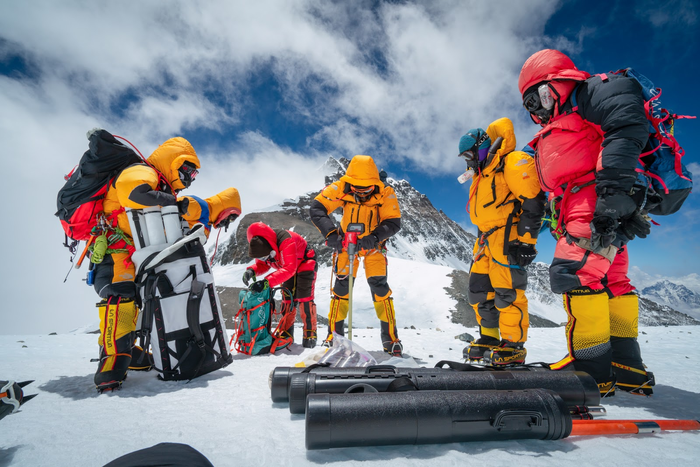Mt. Everest's highest glacier lost 2,000 years worth of ice since the 1990s
Even the world's tallest mountain is not safe from climate change.

Even the glaciers on Mount Everest are not safe from climate change, new research suggests.
In a record-setting study, a team of scientists scaled the world's highest peak to monitor the mountain's highest-altitude glacier — the South Col Glacier, standing nearly 26,000 feet (8,000 meters) above sea level — for signs of climate-related ice loss. After installing the two highest weather stations on Earth and collecting the world's highest ice core from the glacier, the team found that South Col is losing ice roughly 80 times faster than it took for the ice to accumulate on the glacier's surface, they reported Feb. 3 in the journal npj Climate and Atmospheric Science.
The team's core analysis showed that ice that took 2,000 years to form on the glacier has completely melted away since the 1990s, and that the glacier is currently losing several decades worth of ice accumulation every year.
Related: 10 devastating signs of climate change satellites can see from space
"[This study] answers one of the big questions posed by our [expedition] — whether the highest glaciers on the planet are impacted by human-source climate change," study co-author Paul Mayewski, a glaciologist at the University of Maine and director of the University's Climate Change Institute, said in a statement. "The answer is a resounding yes, and very significantly since the late 1990s."
The glacier's rapid decline could have serious impacts on the mountain, and those who live near it. The melt may result in more avalanches on Everest, or expose more bedrock that makes the terrain more treacherous for climbers, the study authors found.

'Destined for rapid retreat'
On a recent expedition, 10 researchers climbed to the base of South Col Glacier and installed two weather detection stations — one at 27,600 feet (8,430 m) and the other at 26,200 feet (7,945 m) above sea level. The team also drilled a 32-foot-long (10 m) ice core from the glacier, which would reveal how the glacier ice's thickness has changed over time.
Get the Space.com Newsletter
Breaking space news, the latest updates on rocket launches, skywatching events and more!
With this data in hand, the team ran computer models to simulate the glacier's growth and retreat over thousands of years. The team concluded that South Col Glacier has lost more than 180 feet (54 m) of ice thickness in the last 25 years. While the effects of wind and changes in humidity may have contributed somewhat to this ice loss, human-induced climate change is the overwhelming cause, the researchers said.
In fact, the team found that South Col Glacier may have begun thinning from climate change as early as the 1950s. However, by the 1990s, the melt rate accelerated significantly when the glacier's snowpack (the outer layers of snow that accumulate over time) finally disappeared, exposing the glacier's raw ice to the sun's radiation. Now, missing its shield of white ice to reflect the sun's rays, South Col Glacier seems "destined for rapid retreat," the researchers wrote in their study.
Ultimately, while South Col is just one glacier among many in the Himalayas, its position at the top of the world shows that no ice mass is safe from climate change. If the same melting trends occur in other glaciers across the Himalayas, then the glacier-stored water that more than 1 billion people depend on for drinking water and irrigation could start to deplete significantly, the authors said.
Future research must focus on how widely these melting trends apply to other glaciers at the top of the world, the researchers concluded.
Originally published on Live Science.
Join our Space Forums to keep talking space on the latest missions, night sky and more! And if you have a news tip, correction or comment, let us know at: community@space.com.

Brandon has been a senior writer at Live Science since 2017, and was formerly a staff writer and editor at Reader's Digest magazine. His writing has appeared in The Washington Post, CBS.com, the Richard Dawkins Foundation website and other outlets. He holds a bachelor's degree in creative writing from the University of Arizona, with minors in journalism and media arts. He enjoys writing most about space, geoscience and the mysteries of the universe.

